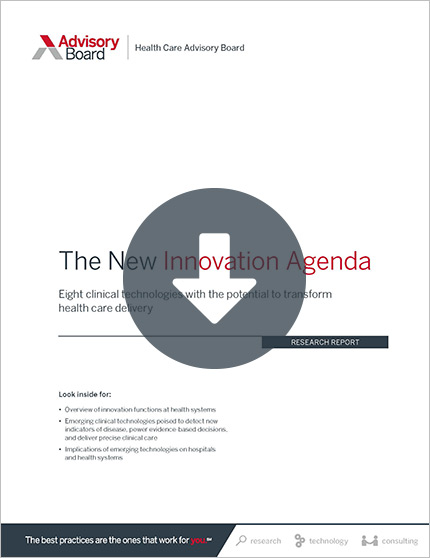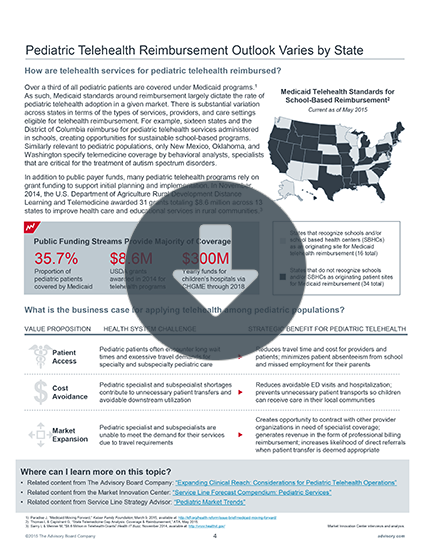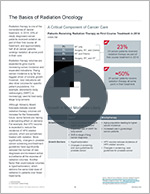Auto logout in seconds.
Continue LogoutParents magazine on Wednesday released a list of the 20 most innovative children's hospitals in the United States.
To compile the list, Parents magazine surveyed 162 hospitals that are members of the Children's Hospital Association. Parents used the survey to identify hospitals that are pioneering advances that benefit pediatric patients in different specialties—including neonatal care, family support, and cancer research. Parents also considered a hospital's patents and partnerships.
Of this year's 20 most innovative hospitals, 18 are Advisory Board members. See the full alphabetized list, as well as a brief description of how they earned their spots on the list, below.
Note: A star denotes an Advisory Board member.
1. Akron Children's Hospital* (Akron, Ohio)
Children's hospitals are increasingly prioritizing mental health, and with this in mind, Akron Children's Hospital has counselors partner with pediatricians at 26 of its 27 primary-care locations. Mary Beitko, whose son is a patient with ADHD at Akron Children's, said the presence of mental health experts makes it easier for parents to schedule counseling appointments and allows the "counselor and pediatrician to coordinate about ... medications."
2. Ann & Robert H. Lurie Children's Hospital of Chicago* (Chicago)
Ann & Robert H. Lurie Children's Hospital of Chicago uses "tech-savvy" solutions to help parents monitor their children's care and progression, according to Parents. The NICU@HOME app, available in January 2019, allows parents with premature babies to check their baby's progress and access personalized educational materials, while another app allows parents to be present in daily bedside rounds at the pediatric ICU through a virtual, webcam setup.
3. Boston Children's Hospital (Boston)
Boston Children's Hospital has shortened operating times with 3-D operating models, which allow providers to practice complex operations before they step into the OR. The hospital also developed a digital platform available at 1,600 facilities in 45 states for families to use to find a ride to an appointment.
4. Children's Healthcare of Atlanta* (Atlanta)
Doctors at Children's Healthcare of Atlanta may soon provide infants born with underdeveloped hearts with dime-sized patches of recycled discarded cardiac stem cells, which researchers think "will strengthen the heart's right side so it can compensate while doctors redirect blood away from the left side," explained Michael Davis, director of the Children's Heart and Outcomes Research Center. Older pediatric patients, meanwhile, can get trading cards that feature the hospital's 16 therapy dogs.
5. Children's Hospital Colorado* (Aurora, Colorado)
Inspired by a lung surgery, Joel Friedlander, a pediatric gastroenterologist at Children's Hospital Colorado, discovered a way to conduct biopsies in under five minutes—as opposed to a day. Friedlander uses a small endoscope to conduct biopsies on children with esophagus inflammation, which reduces the need for general anesthesia and allows parents "a chance to see everything, and they can hold their kid's hand," Friedlander said.
6. Children's Hospital of Philadelphia* (Philadelphia)
In partnership with the University of Pennsylvania and Novartis, Children's Hospital of Philadelphia (CHOP) "pioneered" CAR T-cell therapy, which trains a patient's white blood cells to attack leukemia before returning the cells to the patient's body, Parents reports. "The therapy has put 80 to 90% of children in remission, and more than half of them are still in remission," said Stephan Grupp, director of CHOP's Cancer Immunotherapy Program, who performed the first treatment 2012.
7. Children's Hospital of Wisconsin (Milwaukee)
Parents of children with diabetes can easily track their child's blood-sugar levels and carb intake with Children's Hospital of Wisconsin's BLUELOOP mobile app. The app allows parents to comment on the child's records and share the information with pediatricians.
8. Children's National Health System* (Washington, D.C.)
Children with osteoid osteoma, or bone tumors, do not have to undergo the standard treatment of radiation and muscle drilling at Children's National Health System. The hospital reduces the recovery time and risk of complications of treatments by using sound waves to destroy the tumors.
9. Cincinnati Children's Hospital Medical Center* (Cincinnati)
The neonatal intensive care unit (NICU) at the Ohio-based hospital has a tiny MRI developed for babies that provides images in 10 to 30 minutes. With the innovation, doctors at Cincinnati Children's Hospital Medical center can avoid moving "fragile babies" to other units for MRIs, according to Parents, and doctors use "complementary techniques like swaddling," to avoid sedating infants, according to James Greenberg, director of neonatology.
10. C.S. Mott Children's Hospital/University of Michigan Health System* (Ann Arbor, Michigan)
C.S. Mott Children's Hospital uses a 3-D printer to create custom implants for children whose windpipes collapse periodically. Surgeons sew the biodegradable implant around the patient's airways to prevent collapse and to help them grow normally.
11. Johns Hopkins Children's Center* (Baltimore)
Johns Hopkins Children's Center encourages patients to play, ride scooters in the halls, and explore the rooftop garden with the pediatric intensive-care unit's PICU Up! Program. The hospital developed the program based on research that shows kids get better rest and recover faster when they are active.
12. Nationwide Children's Hospital* (Columbus, Ohio)
A new mobile app called Make Safe Happen keeps families at Nationwide Children's Hospital safe by preparing families and children for emergencies through safety checklists and calendar reminders. The hospital has also worked with engineering students from Ohio State University to provide rewired toy guitars, battery-operated cars, and plush toys to children who have difficulty with fine motor skills.
13. Seattle Children's Hospital* (Seattle)
Seattle Children's Hospital, part of the St. Baldrick's Foundation's Stand Up to Cancer Pediatric Cancer Dream Team, is focusing on developing new treatments for hard-to-cure cancers. As part of that effort, doctors at Seattle Children's are working on a vaccine to elongate the lifespan of programmed T cells, and are researching a way to train T cells to attack neuroblastoma and brain tumors.
14. St. Jude Children's Research Hospital* (Memphis)
Analyzing genome sequences requires a lot of time and data, but St. Jude Children's Research Hospital sped up the process by working with Microsoft and data-management company DNAnexus to host a "one-of-a-kind cloud-based system" to cut down "a project that used to take ... two years" to "a long weekend," according to Jinghui Zhang, chair of computational biology. The St. Jude Cloud, which launched in April, helped confirm a link between UV damage and mutations in pediatric B cell leukemia patients.
15. UCLA Mattel Children's Hospital* (Los Angeles)
At UCLA Mattel Children's Hospital, Gay Crooks is researching how to improve pediatric cancer treatment by producing T cells that fight cancer. The development will be useful for patients who do not have enough cells to undergo T cell treatment, according to Parents.
16. UH Rainbow Babies & Children's Hospital* (Cleveland)
With UH Rainbow Babies & Children's Hospital's Medeject, children can receive treatment for an allergic reaction without having to use an EpiPen. The alternative device, which its inventor says should be available for sale in a few years, uses a small needle to inject medicine at the push of a button.
17. University of Minnesota Masonic Children's Hospital* (Minneapolis, Minnesota)
The University of Minnesota Masonic Children's Hospital prioritizes children's mental health with the Birth to Three Clinic and Early Childhood Mental Health Program. The program is designed for young children—whose brains are very adaptable—who show early signs of anxiety or poor impulse control.
18. University of Rochester Medical Center's Golisano Children's Hospital* (Rochester, New York)
Instead of going through an MRI and a PET scan, Golisano Children's Hospital have a scanning device that allows kids to get both scans at once. The Golisano Children's Hospital is the first to have the scanning device, which is shaped like a pirate ship.
19. UPMC Children's Hospital of Pittsburgh* (Pittsburgh)
Research at UPMC Children's Hospital of Pittsburgh shows that the "distressing" side effects of antibiotics used to treat ear infections in babies and toddlers, like diarrhea and diaper rash, can be reduced by changing the amount of clavulanate in the antibiotic. FDA will test the hospital's new formula with reduced clavulanate—and equal effectiveness—for approval within the next two years.
20. Yale New Haven Children's Hospital* (New Haven)
Mothers no longer have to be separated from their children when their sick babies are admitted to Yale New Haven Children's Hospital's NICU. The hospital offers couplet care, which allows moms and NICU babies to share a room. "Learning that I could recover in the same room as my baby was boost during a terrifying labor," said Jen Stauffer, whose son Anders was a patient in the NICU (Knowles, Becker's Hospital Review, 9/5; Cicero/Straetker, Parents; 9/5; Parents press release , 9/5).
Here are 8 innovative technologies with the potential to transform health care
This research report explores the clinical technology pipeline to help health care leaders become more conversant in the major vectors of innovation, leading applications of new technologies, and the business implications for established providers.
Don't miss out on the latest Advisory Board insights
Create your free account to access 1 resource, including the latest research and webinars.
Want access without creating an account?
You have 1 free members-only resource remaining this month.
1 free members-only resources remaining
1 free members-only resources remaining
You've reached your limit of free insights
Become a member to access all of Advisory Board's resources, events, and experts
Never miss out on the latest innovative health care content tailored to you.
Benefits include:
You've reached your limit of free insights
Become a member to access all of Advisory Board's resources, events, and experts
Never miss out on the latest innovative health care content tailored to you.
Benefits include:
This content is available through your Curated Research partnership with Advisory Board. Click on ‘view this resource’ to read the full piece
Email ask@advisory.com to learn more
Click on ‘Become a Member’ to learn about the benefits of a Full-Access partnership with Advisory Board
Never miss out on the latest innovative health care content tailored to you.
Benefits Include:
This is for members only. Learn more.
Click on ‘Become a Member’ to learn about the benefits of a Full-Access partnership with Advisory Board
Never miss out on the latest innovative health care content tailored to you.



